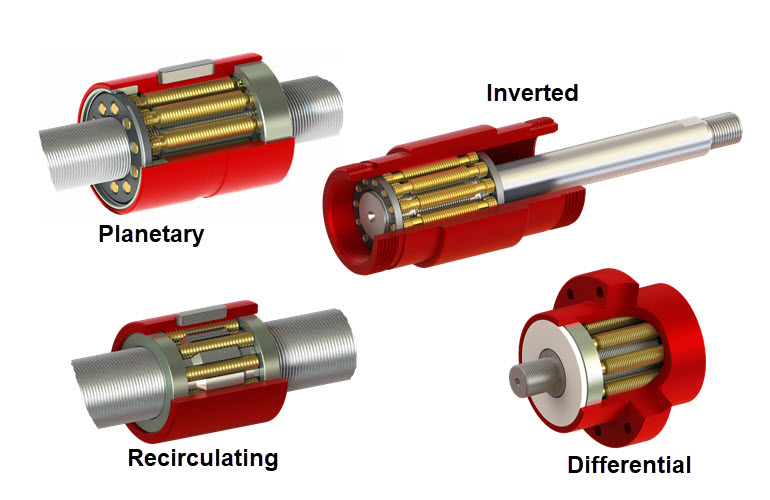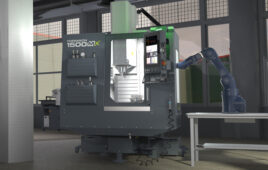
By Michael Boudreau, P.Eng., Application Engineering Manager
As a relatively young technology, and with their initial applications being in heavy industries such as injection molding, roller screws are often considered to be best suited for applications where they replace hydraulic cylinders or other high-load drive mechanisms.
And, yes, some roller screw designs are ideal for heavy-duty applications, but roller screws also provide solutions to other design challenges, such as the need for precise, sub-micron positioning or for special nut designs and customer-specified materials.
Here, we’ll look at four roller screw designs, explain their unique operating principles and performance characteristics, and provide examples of applications where each type of roller screw excels.
Planetary roller screws: The “workhorses” of the roller screw family

The planetary roller screw design uses five primary components – a screw, a nut, satellite rollers, synchronizing gears, and guide rings. The guide rings and synchronizing gears are located at each end of the nut, and the ends of each roller have cylindrical pivots and gear teeth.
The pivots of the rollers are mounted in the holes of the guide rings, which keeps the rollers equidistant. The gear teeth on the ends of the rollers engage with the synchronizing gears, guiding the rollers parallel to the axis of the screw. Careful design geometry and precise manufacturing ensure there is no axial movement between the rollers and the nut.
These very stable kinematics allow planetary roller screws to achieve higher speeds and accelerations than ball screws and ensure that the screw continues to function even under adverse operating conditions. And the use of rollers to support the load gives roller screws higher load capacities and better rigidity than similarly sized ball screws, with the same or similar efficiencies.
Inverted roller screws: Invert the nut, customize the shaft
In the inverted roller screw design, the synchronizing gear is cut directly into the shaft, which allows the nut to have a smaller outer diameter than the nut of a planetary assembly with the same size screw shaft. And the inverted design typically has three starts, whereas a standard planetary roller screw typically has five or six starts. With fewer starts, the inverted design can use a larger thread form and, in turn, provide higher load capacity than a standard planetary design.
Because the screw shaft of an inverted roller screw is only threaded for a section equal to the length of the rollers, the rest of the shaft can be customized, making inverted screws ideal for integration into systems such as linear actuators.

An inverted roller screw in a linear actuator. Courtesy of Diakont
Recirculating roller screws: Accurate positioning with low torque
Recirculating roller screws are designed specifically for small, precise movements with high rigidity and for applications where the available motor torque is limited.
The core components of a recirculating roller screw are the same as those used in the planetary roller screw. But the rollers in a recirculating roller screw have circular grooves (no helix angle), rather than the threads found on traditional rollers.
The rollers are held in a cage with slots that are slightly longer than the roller length. Because the rollers are grooved rather than threaded, when the screw shaft turns, the rollers move axially in the nut, along the length of the slotted cage. This axial movement means the rollers need to be recirculated. Once a roller makes a complete revolution around the screw shaft, cams at each end of the nut disengage the roller from the screw shaft and return it to its initial position, but advanced by the amount of the screw lead.
The recirculating design requires only a single- or double-start screw thread, which means it can be manufactured with very fine or fractional-millimeter leads, such as 0.25 mm – even for large screw diameters. And a smaller lead means less required input torque. This makes recirculating roller screws ideal for applications that require accurate positioning with high rigidity, such as grinding equipment, semiconductor manufacturing, and lens focusing.

RVR recirculating roller screws are used in an ultra-high a vacuum wafer handling robot, achieving +/- 2 μm positioning accuracy. Courtesy of Trust Automation
Differential roller screws: Sub-micron positioning
Differential roller screws are so named because they operate based on differential movements between the internal components. This differential makes it possible to have an extremely small lead, or linear travel distance, for each revolution of the screw. How small? Differential roller screws can have leads as small as 0.03 mm. And when used with a linear scale, they can precisely move in increments smaller than 0.001 mm.
Differential roller screws combine sub-micron positioning with the ability to provide high thrust forces and rigidity. Differential designs also have high efficiency, which allows them to be backdriven. This unique combination of performance characteristics makes them well-suited for specialty designs, such as high-precision scientific equipment and satellites.

An RVD differential roller screw is used as part of an electron beam bending assembly within the Swiss Light Source SLS. Courtesy of the PSI institute
Which roller screw technology is right for you?
Planetary roller screws fit a wide range of applications that require high speed, high load capacity, and high rigidity. Inverted roller screws offer the same benefits, but with a better force-to-size ratio and the ability to easily customize the screw shaft, making them ideal for integration into actuators and other linear motion systems.
Recirculating roller screws offer micron-level positioning capabilities for applications where both positioning accuracy and rigidity are critical. And differential roller screws offer the unique combination of sub-micron positioning, good thrust force, and high rigidity for the most challenging, high-precision applications.

With multiple design variations – from planetary to differential types – roller screws can address a wide range of application requirements. But all these variations have two things in common: high thrust force capabilities and high rigidity.
As specialists in roller screw technologies since 1970, Rollvis manufactures planetary, inverted, recirculating, and differential roller screws, with a highly skilled workforce and the most modern equipment available. Our roller screws are the preferred choice in the most demanding, complex applications – from industrial presses to semiconductor manufacturing and space-based telescopes.

Sponsored content by Rollvis
Filed Under: SPONSORED CONTENT




